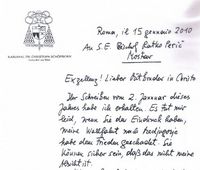January 2010 Archives
For his birthday today, 65-year-old Cardinal Schönborn has given an interview to a friendly local church-news outlet. Kath.net is also friendly to the alleged Medjugorje apparitions, and in fact sells videos of the Cardinal's recent "pilgrimage" there. In the interview, he confirmed a bit of news from a Petrus article that appeared here on January 12: that Pope Benedict will soon create a new commission to evaluate the controversial site of alleged apparitions.
My translation:
KATH.NET: In the past few days, you visited Pope Benedict XVI. Did you tell him about your positive experiences of Medjugorje? Did he express any opinion about it?
Cardinal Schönborn: It's not customary to talk about audiences. But I can naturally say this much: that Medjugorje was a topic in Rome during those days, due to the public awareness of my pilgrimage. I reported about my impressions in Rome. And I am very confident that the Commission, which the Holy Father is setting up to examine the events of Medjugorje, is very good and will work very conscious of its responsibility, and that the result will certainly be good. And I am confident that it will proceed with great prudence and great sensitivity to a phenomenon that has attracted about 30 million pilgrims and brings very many good fruits, but certainly also some open questions.
As a skeptic about the phenomenon, I didn't appreciate his recent highly publicized visit there, but I am glad to see the Cardinal acknowledge that there are some, ahem, questions to be examined.
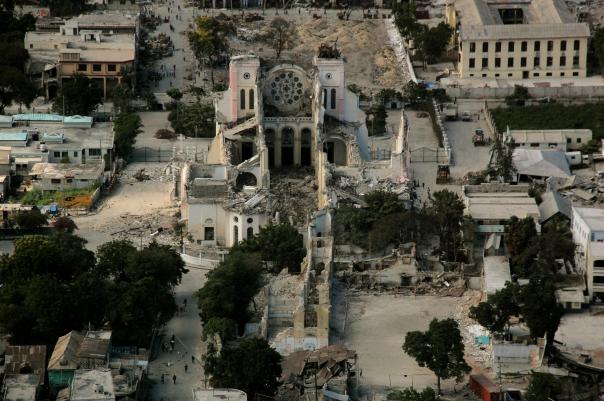
Aid to the Church in Need is continuing to work toward the Church's recovery in Haiti.
(Photo: the cathedral in Port-au-Prince; source: foxnews.com blog)
The German-language service of Vatican Radio has an article on Cardinal Schönborn's private audience with the Holy Father last Friday, and the letter he faxed to Bishop Perić the same day.
My translation:
Schönborn: Apology for Uproar about Medjugorje Visit
After his controversial pilgrimage to Medjugorje Cardinal Christoph Schönborn has apologized to the local bishop of the place, Ratko Perić. In a letter published in excerpts on the official home page of the Mostar diocese, the Vienna cardinal emphasizes that he had no intention of "harming peace." Schönborn had visited the village of Medjugorje in Bosnia-Herzegovina at the end of the old year and argued for "an integration of the Medjugorje phenomenon into normal pastoral practice". He had declared his visit to the ecclesiastically unrecognized site of Marian pilgrimages a private trip. However, he provided for considerable visibility to it in media publicity. The letter of apology is dated January 15, the day on which Schönborn was in Rome for a private audience with Pope Benedict. With his letter, Schönborn answered a letter from Perić, who had sharply criticized the visit of the cardinal to Medjugorje and emphasized that the visit implied no recognition of the "apparitions". Furthermore he recalled that the so-called seers of Medjugorje had repeatedly manipulated the alleged Marian apparitions. With Schönborn's letter the discussions are now considered closed, said a spokesman for the Mostar-Duvno diocese this Tuesday. -- Since 1981, Marian apparitions are said to be taking place in Medjugorje. They are not recognized either by the local diocese or by the Vatican.
Whenever I turn on the TV or radio, the news is right in my face: there's obvious danger, desperate people are crying for help, trapped in wreckage that has collapsed after decades of corruption and shoddy work; outsiders are trying to rescue them, appealing for money, but it may be too late to save Martha Coakley.
I gave twenty-five bucks to Scott Brown's senatorial campaign yesterday. I rarely donate to political campaigns, since we usually blow our money on extravagances such as food and chidren's clothing (can't they stop growing, at least for a year or so?) I'm quite sure I've never given money to a candidate who wasn't completely pro-life. I don't think I've ever donated to an out-of-state campaign, either.
But this seems important. Brown might be ostensibly "pro-choice," but on life issues that are likely to come up in the Senate in the near future (the "conscience clause," Federal funding for abortion, partial-birth abortion) he is on the right side. Even more than that, he has promised -- in explicit terms -- to fight the monstrous health-care legislation that is oozing its way through Congress.
I'm sure most pro-lifers in Massachusetts are planning to vote for Brown on Tuesday. For those who aren't, do you honestly think that if the Federal government regulates all aspects of our health care that our country will be more friendly to life? Nonsense. Look at Western Europe -- not, as many conservatives do, because of the quality of their health care. No, look at how they treat their own population. Once a national government starts taking care of its citizens like pampered children, it will start regarding its citizenry as a burden, and will take steps to lighten that burden. A look at Europe's birthrates will help confirm that theory.
President Obama is a committed statist, believing that there is no area of human life outside the government's regulatory sphere. Statism is the political ideology of the cuture of death, squeezing out the family, religion, businesses, private associations, and all the other institutions of free peoples. Absurdly, he spoke out today in the name of independence, saying that Attorney General Coakley would represent the people of Massachusetts over her party.
This is one of Obama's favorite verbal ploys: accusing opponents of something he himself is doing, or saying he isn't doing X, when he is indeed doing X. The whole reason he was in Massachusetts was to support a member of his own party's senatorial campaign, so she would vote in lockstep with the 59 other members of the Democrat caucus. If he had promised to oppose the health care bill, or any other item on Obama's agenda -- which would signify something like independence -- you can bet that he wouldn't have made the trip.
"...[I]t's easy to say you're independent, and you're going to bring people together, and all that stuff, until you actually have to do it," said Obama at the 14:50 mark in his speech. He should know, since he's managed to alienate virtually all Republicans since his inauguration a year ago. But maybe that's not giving him enough credit. The polls tell us that independent voters across the U.S. oppose Obama by a 2-1 ratio, and that Massachusetts independents are going for Brown by a similar proportion. So it looks like Obama is uniting the country after all, just not in the way he had hoped.
May I commend to your attention the very fine charity Aid to the Church in Need, which has been providing direct aid to the Church in poor countries and situations of persecution for over 50 years?
After meeting with the Pope on Friday, Cdl. Schönborn faxed a conciliatory letter from Rome to Bishop Peric in Mostar; it is available on the Mostar diocesan website. Now that there is some communication between the two prelates, I hope it will serve to bring some good and some common understanding from the recent unfortunate events around the Cardinal's visit.
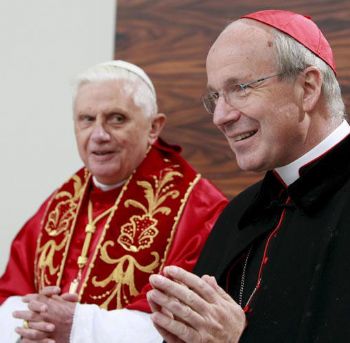 From the Italian web site Petrus (my translation):
From the Italian web site Petrus (my translation):
Rumors from the "Sacri Palazzi": the Pontiff calls Cardinal Schönborn into line: "More prudence about Medjugorje". The cardinal traveled there December 31.
VATICAN CITY - The Pope did not welcome the end-of-year visit to Medjugorje by Cardinal Christoph Schönborn, Archbishop of Vienna and his former student at university. According to word filtering out from the "Sacri Palazzi" (there has been no official statement on the subject), Benedict XVI has personally communicated with the Austrian cardinal, receiving him in audience a few days after the arguments sparked by the journey of the prominent prelate to the small village in Bosnia-Herzegovina in which six alleged seers have claimed to see the Madonna since the 1980s. The Bishop of Mostar (the diocese in which Medjugorje is located), Monsignor Ratko Peric -- steadily convinced, like his predecessor, that the Virgin is absolutely not appearing in the village -- lamented in an official note that he had not been warned by Schönborn in advance of his arrival. The Archbishop of Vienna, for his part, after having prayed and said Mass at Medjugorje on December 31, also expressed his favorable judgment on what is said to have happened there, and had one of the six alleged seers who claim to see and speak with the "Gospa" accompany him. Then, as the Holy See has not yet expressed itself on the apparitions and many Cardinals and Bishops have shown their skepticism on the authenticity of the apparitions, Benedict XVI has therefore asked Schönborn for more prudence in statements relative to Medjugorje (the destination, this year, of millions of pilgrims), so that his presence there, as a member of the College of Cardinals, not be exploited by anyone to "authenticate" phenomena which the Holy See intends to monitor and analyze, besides the ordinary way, with an ad hoc Commission to whose guidance Cardinal Camillo Ruini will reportedly be called. The most recent Prince of the Church to express his own perplexity on the Medjugorje apparitions (in an interview in these pages) was the Cardinal José Saraiva Martins.
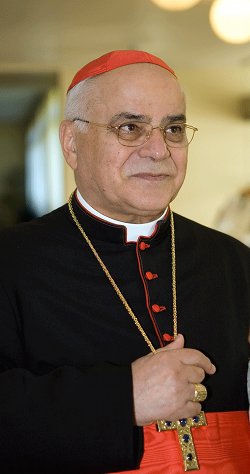 The Italian Catholic website Petrus has published an interview with the former prefect of the Congregation for the Causes of Saints, José Cardinal Saraiva Martins. Cardinal Saraiva has joined in the public debate about the alleged apparitions at Medjugorje in Herzegovina by expressing his own skeptical take on the phenomenon. Here's a translation of the interview. Corrections to the translation are welcome.
The Italian Catholic website Petrus has published an interview with the former prefect of the Congregation for the Causes of Saints, José Cardinal Saraiva Martins. Cardinal Saraiva has joined in the public debate about the alleged apparitions at Medjugorje in Herzegovina by expressing his own skeptical take on the phenomenon. Here's a translation of the interview. Corrections to the translation are welcome.
[Welcome, readers from Catholic World News, Mark Shea (Catholic and Enjoying It), Medjugorje Forum, Patrick Madrid, etc.]
Cardinal Saraiva, also, is a skeptic about the apparitions at Medjugorje: "The last word is up to the Holy See, but this has nothing to do with Fatima: it could be a trick of the devil"
by Gianluca Barile
VATICAN CITY - The alleged apparitions of Medjugorje continue to inspire debate and sustain polemics, within and without the Church. Thus the presence at New Year's of Cardinal Christoph Schönborn, the Archbishop of Vienna, in the little Bosnia-Herzegovina locality, was only the most recent occasion to confirm the tension existing in the place where, since the 1980s, the Madonna is said to have appeared to six "seers". The Austrian cardinal, in fact, celebrated Mass for the faithful coming from around the world, but did not inform the diocesan bishop, Monsignor Ratko Peric, of his presence. Bishop Peric, is still, like his predecessor, unconvinced of the validity of the phenomena, and has publicly objected in the face of what he, evidently, considers an offense. All that has happened, while Pope Benedict XVI, who has had the opportunity to deal with Medjugorje since he was Prefect of the Congregation for the Doctrine of the Faith, is said to have decided (but there has been no official confirmation of the matter yet) to entrust to Cardinal Camillo Ruini the coordination of a Commission to definitively ascertain the truth on the authenticity, or lack thereof, of the apparitions in this small country of the former Yugoslavia. But what, then, are the fruits of Medjugorje? Those who believe in the seers speak of miraculous cures, deliverances from evil, conversions; it is beyond doubt that many people pray, receive Holy Communion, and make confessions in the town. But the "skeptics", those who do not believe in the authenticity of the apparitions, underscore the division among the people of God, between supporters and opponents, to show that this is a case of deception. "Devil", after all, means: "he who divides". We spoke about this complicated event with the Portuguese Cardinal José Saraiva Martins (see photo), a close and trusted collaborator first of the Venerable John Paul II and later of the Supreme Pontiff Benedict XVI; rector of the 'Urbaniana' University much praised by Paul VI; a theologian, former Prefect of the Congregation for the Causes of Saints and a great expert on the Marian apparition, officially recognized by the Church, of Fatima.
Eminence, in your opinion, are the alleged apparitions of Medjugorje to be considered true or false?
"There is no doubt: the apparitions will not be considered authentic, as long as they have not been officially approved by the Church in the person of the Holy Father."
It is said that the Holy See wants to wait as long as possible before expressing itself.
"To me, this seems the best way of proceeding. The Church does very well to be prudent in the face of events so delicate, which inevitably involve the feelings of millions of the faithful."
How should a faithful Catholic who wants to go on pilgrimage to Medjugorje proceed?
"He must not take for granted and must not become convinced that the apparitions are authentic; therefore, he must go to the place to pray, but not through his presence to acknowledge the authenticity of phenomena whose approval depends solely and exclusively on the Church, and which in any case neither subtracts nor adds anything to Revelation, which is already complete in Christ."
And are the conversions a sufficient reason to believe in Medjugorje?
"Absolutely not; whether about conversions, or also about healings, it is not a sufficient argument to evaluate the thesis of the authenticity of the apparitions. Just because people convert in this place, it is not given that the Madonna is appearing. Conversion is also possible in a little country parish."
Let's turn to the "seers". Some people accuse them of having invented everything, and of having economic interests, and some think that in reality, the demon is appearing to them in the guise of the Madonna in order to bring divisions into the Church, even at the price of some conversions, Do you not think so?
"I don't know if these apparitions were invented or if they have economic interests; for sure, in cases of this sort, the devil's paw may be here. But God is so great that he knows how to make even the evil one serve for the good of humanity: in this way, it is possible to explain the benefits which many people maintain they received at Medjugorje."
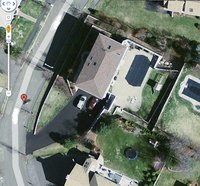 Again in reference to the "seers", none of them, in contrast to the overwhelming majority of other seers recognized officially by the Church, has chosen consecrated life. One of them has even married an American model and lives in the USA in a mega-villa with a swimming pool.
Again in reference to the "seers", none of them, in contrast to the overwhelming majority of other seers recognized officially by the Church, has chosen consecrated life. One of them has even married an American model and lives in the USA in a mega-villa with a swimming pool.
"Consecrated life would have been a beautiful testimony on the part of these people, but I see that there is a great difference from Fatima, where the three little shepherds chose to be even more little and humble than even they already were, in order to live in fullness the great gift of the apparitions."
On this subject: the "seers" assert that the apparitions of Medjugorje are the natural successors of the apparitions of Fatima.
"I don't believe that they are. I see too many differences. As I said before, the little shepherds of Fatima made themselves humble and chose silence; at Medjugorje, I don't know if that is going to happen; Sister Lucia entered the cloister, at Medjugorje, no one has chosen consecrated life; the same Sister Lucia put into writing the secrets entrusted to her by the Madonna, while at Medjugorje they continue to keep them for themselves. No, I see nothing in common between Fatima and Medjugorje."
Eminence, in some of the apparitions, the Virgin is said to have asked the six "seers" of Medjugorje not to obey the prohibitions of their diocesan Bishop, such as, for example, to not speak publicly any more of the alleged "visions".
"The Madonna could not, in any case at all, be anti-hierarchical and incite disobedience, even if the Bishop of Mostar were wrong. This is another element on which to reflect."
The Bishop of Mostar recently made known his own displeasure at not being informed of the presence of Cardinal Schönborn at Medjugorje. A "weighty" presence, that some could interpret erroneously as a recognition of the apparitions on the part of the Holy See.
"Far be it from me to think of judging the conduct of Cardinal Schönborn, but I, considering the morbid attention which is concentrated on Medjugorje, and as I always do every time I go out from Rome, would have spoken beforehand with Monsignor Peric: when we Cardinals enter into a Diocese, we are entering into the "house" of the Bishop of the place and we must have the good manners and good sense to announce ourselves."
An acquaintance on Facebook posted an item about an upcoming retreat put on by one of the promoters of doubtful mystical messages. I won't give the details here, but here's my reaction.
First, a word from Scripture: 2 Tim. 4:3-4 (RSV):
3 For the time is coming when people will not endure sound teaching, but having itching ears they will accumulate for themselves teachers to suit their own likings, 4 and will turn away from listening to the truth and wander into myths.
These nut cases with all their phony apparitions and mystics and apocalyptic stuff run retreats? Oy. As in the times of St. Paul, people want to have their "ears tickled", so they go chasing after phony mystical messages instead of devoting themselves to classic doctrine, Scripture, etc. People want to be "in" on the latest "message from God" and "know" what's "really happening" -- the result is a sort of gnosticism disguised as Catholicism.
[UPDATE (1/16): The Mostar diocesan website has picked up this translation of Bishop Peric's statement, and improved it in a few places, so I recommend readers use that edition. I'll leave this draft here, along with my introductory comments.]
One sensational element of the claimed apparition at Medjugorje is in predictions of a "great sign" to eventually appear at the town. According to the alleged seers, the sign would be a miraculous proof of the alleged apparitions' validity, and as such would encourage the world to repent. The "sign" was part of ten apocalyptic "secrets" that the apparition supposedly told to the seers.
On December 11, Bishop Ratko Peric of the diocese of Mostar-Duvno issued a paper relating how this idea got started, and what the seers have said and done in regard to it. This document highlights various contradictions among the seers vis-a-vis each other, and inconsistencies between their earlier and later statements.
It also looks at the apparent falsehoods claimed by "seer" Ivan Dragicevic, who at one point wrote down a prediction of the sign, and later denied having written it.
Bp. Peric begins by addressing the contention of some apparition promoters that all the talk of a "great sign" was invented by other people, and does not come from the seers themselves. Then he proceeds in chronological order through various diaries, books, chronicles, and interviews to present how the idea of the "great sign" first appeared. He also recounts the efforts of two study commissions to explore the question, efforts that were somewhat thwarted by the non-cooperation of the seers.
This document was published on the diocesan website in Croatian and in Italian, and here I present an English translation based on the Italian.
By way of full disclosure: please be aware that I am an amateur in learning the Italian language; any errors or omissions are my responsibility, and I appreciate any appropriate corrections. [Thanks to Marco Corvaglia for sending a correction already.]
[One technical note: the translation of the key words apparizione and apparsa needs a little explanation. Apparizione refers to an apparition as an event; apparsa to the personage or entity that appears. Apparsa, in the feminine gender, indicates a feminine being. In English, both of these words might be translated as "apparition". However, to do so would lead to obscurity, especially in sentences containing both words. Therefore, I translate apparizione as "apparition" and apparsa as "lady". This does not imply any endorsement of the alleged seers' reports.]
To begin with a sample, here is a quotation from Bp. Peric's conclusions:
"The sign" has to be, and may indeed be, the most splendid weapon of the "seers" of Medjugorje and of the propagandists of the "apparitions". The same "seers", from the beginning, have asked the lady that appeared to them for it. They asked for it and "begged" for it, as we have seen. Then, through the "seers", followed whole floods of lies, contradictions, promises, speed-ups, slowdowns, falsehoods, uncertainties.
[UPDATE (1/5): Bishop Peric has issued an English version of his statement on his diocesan website.]
Bishop Ratko Peric of Mostar has issued a letter of public criticism of Christoph Cardinal Schöborn, O.P., the Archbishop of Vienna, for his public statements endorsing the claims of apparitions in Medjugorje.
The Cardinal's latest interference in the case is a so-called "private" visit he made over New Year's. It was so private that it was announced in advance by bloggers, confirmed by the Cardinal's spokesman, and followed by the media when he arrived. It included public celebrations of Mass, a visit to the alleged apparition site in the company of a "seer", and an address in Italian to visitors. However, there was no notice to the local bishop, and not even a courtesy visit.
Bishop Peric has delivered a statement that I find refreshingly frank. I can't remember anything comparable from a bishop, really. Here are some quotes (my translation from the Italian version on Bp. Peric's diocesan site):
- "I am surprised because no one from Cardinal Schonborn's office has contacted me, even up to the publication of this statement,"
- "I suppose that the Cardinal knows the position of the Church, based on the findings of the commission and its conclusion that no one can say that these are "supernatural apparitions or private revelations."
- "His visit ... [to religious orders operating in the diocese without permission] can be read as an encouragement for their ecclesiastical disobedience."
- "the Cardinal, with his visit, appearance, and statements, is adding to the present suffering of the local Church"
Diane Korzeniewski has posted an English version on her blog.

